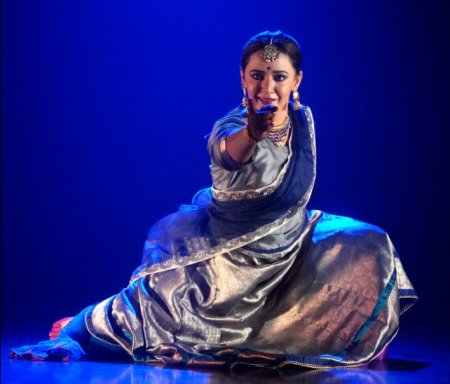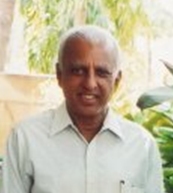
|   |

|   |
Maathe and Nadanth - Satish Suri e-mail: satishism@yahoo.co.in Photos: Prof K.S.Krishnamurthy April 13, 2024 The celebration of International Women's Day at the Bangalore International Centre featured two esteemed artists from Delhi, showcasing the vibrant diversity of classical dance forms. Shreyasi Gopinath delighted the audience on March 12th with her Bharatanatyam presentation titled 'Maathe,' while Divya Goswami enthralled them with her Kathak performance titled 'Nadanth' on March 13th. MAATHE Shreyasi Gopinath began her performance with a recitation of the poem "My Mother" by Ann Taylor, setting the emotional tone for the evening. She then performed a Pushpanjali in Ahir Bhairavi, a traditional opening piece, which was followed by a Sanskrit sloka "Nasti maata samaa chaya," emphasizing the significance and irreplaceable role of a mother.  Shreyasi Gopinath The Varnam "Maathe malayadhwaja" by Muthiah Bhagavathar, as interpreted by Shreyasi vividly portrays the divine energies of Goddesses Lakshmi, Saraswati, and Parvati. Through meticulous craftsmanship, the artiste depicted various forms of the goddess, including Ganapati and Kartikeya Guha. The composition alternated between nritta sequences and teermanams, enhancing its artistic appeal. The choreography of the images of Shankari and Chandrakaladhari demonstrates imaginative flair, emphasizing the gentle and serene qualities of the goddess. In contrast, the depiction of Chamundeshwari exudes a sense of awe, with wide-open eyes and extended arms, effectively conveying the formidable aspect of the goddess. The epithets of Ruchir geet, Vividha samarasa, Sulabh hridaya, Madhur swara, and Karuna Sagar, like an ocean of compassion, bestow blessings upon King Krishna Rajendra, Sakalajiva sarvabhaume, ruling over the universe, seen in Shashimandal as Jaganmata. The artiste's aesthetic patterns contributed to the overall beauty and complexity of the composition, enhancing its artistic appeal and narrative depth. The dance "Maadu meikum kanne" artfully portrayed this heartwarming and relatable interaction, depicting the endearing bond between a mother and her spirited son. The exchange captured the timeless essence of maternal concern, a child's playful determination, and the tender negotiations that unfold between them, ultimately culminating in a touching display of love and understanding. "Yethanai sonnalum" in Saveri portrayed a poignant scene of a mother admonishing her daughter, who has left her husband after a disagreement. The mother's concern is palpable as she reminds her daughter of the dangers of letting anger cloud her judgment. She encourages reconciliation and emphasizes the importance of striving for happiness and harmony in married life. The dancer skillfully captured the emotional intricacies of the narrative, conveying the depth of the character's feelings and the complexity of their relationship dynamics. Shreyasi concluded with a vibrant Thillana in Dhanasri, a composition by Maharaja Swati Tirunal. This piece served as a fitting finale, incorporating all the dynamic elements necessary to leave a lasting impression. Following the Thillana, the performance concluded with a shloka encapsulating the idea that divinity flourishes where women are honoured. The performance was supported by music on a recorded track. NADANTH - ETERNAL AWARENESS The recitation at the beginning of Divya Goswami's Kathak performance set the tone and context for the artistic expression that followed. It provided a philosophical and introspective introduction, creating a contemplative atmosphere that aligns with the traditional and spiritual aspects of Kathak. The recitation's profound message about surrendering to the light of love and the dance of eternal awareness established a thematic foundation for the subsequent dance performance. By incorporating this recitation, Divya infused her Kathak performance with deeper meaning and spiritual resonance. The musical refrain of the Dhrupad song "Gale bhujang bhasma ang Shankar anuragi" in raag Desh set to chautaal, beautifully rendered by Sudha Raghuraman, intricately described the various features of Shiva. The imagery of Shiva adorned with a serpent around his neck, an ash-smeared body, and a garland of skulls symbolizes his transcendence beyond worldly attachments and illusions. It depicts Shiva in deep meditation, embodying detachment and dispelling negativity. Parvati's perception of an effulgent, endless light when meditating on Shiva underscores the divine nature of his being.  Divya Goswami Divya Goswami's Kathak performance further explored the symbolic significance of the serpent, aligning with the traditional association of serpents with Shiva's adornments. The dancer transcended literal interpretation to convey a profound narrative, symbolizing the serpent's energy as a cleansing and evolutionary force in superconsciousness. The use of Kathak's flowing movements, rhythmic patterns, and punctuated pirouettes effectively communicated the serpent's movement in both outer space and as a reflection of the internal journey. Divya's mastery lies in her ability to go beyond technical theatrics, using footwork, facial expressions, and hand movements to vividly depict the rising serpentine kundalini energy. The kavit in 7 beats that followed delved into the profound inquiry regarding the genesis of creation: whether it arises from the fluidity of movement or the transcendental sound of Naad, representing knowledge, beauty, and philosophy. This exploration intertwined with Shiva's visual narrative, guiding humanity towards the authentic purpose of life - the discovery of the divine within oneself. Shiva's sacred drum emanates the sound of wakefulness, signifying a transition from static to dynamic rhythm and encapsulating the transformative potency inherent in dance. Central to the kavit's narrative is the emphasis on directing one's consciousness towards the centre, resonating with Shiva's essence as the epitome of unity and the resolution of all dichotomies. In Shiva's presence, opposing forces merge seamlessly, culminating in a harmonious equilibrium. After this convergence lies a profound silence, wherein absolute balance prevails, revealing the intrinsic truth of existence. Divya's performance reached its crescendo with an exquisite rendition of "Shankara Srigiri Natha Prabhu" by Maharaja Swati Tirunal, which beautifully portrayed the cosmic dance of Shiva. This composition infused the atmosphere with a vibrant energy, enhancing the dynamism of Divya's performance. Overall, her portrayal of Nadanth, characterized by intricate footwork and precise rhythmic patterns, showcased her mastery of the art form. Throughout her performance, Divya epitomized grace, with every movement characterized by sharp finishing and flawless execution. Her creative freezing on the sam, the rhythmic anchor point, was executed with immaculate precision. The recurring serpent motif, intricately woven into her performance, added depth and symbolism, enriching her portrayal of Shiva's divine dance. The delightful music accompanying Divya's performance featured Sudha Raghuraman on vocals, Mudassar Khan on the sarangi, Manohar on mridangam, Aman Ali on tabla, Kiran Kumar on the flute, and Padanth by Dr. Sridhar Vasudevan. The artiste also acknowledged the inputs by Vidhya Subramanian. Together, these talented musicians created a delightful musical backdrop that complemented Divya's performance, captivating the audience with its beauty and intricacy.  Bangalore based Satish Suri is an avid dance rasika besides being a life member of the Music and Arts Society. |